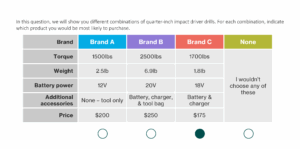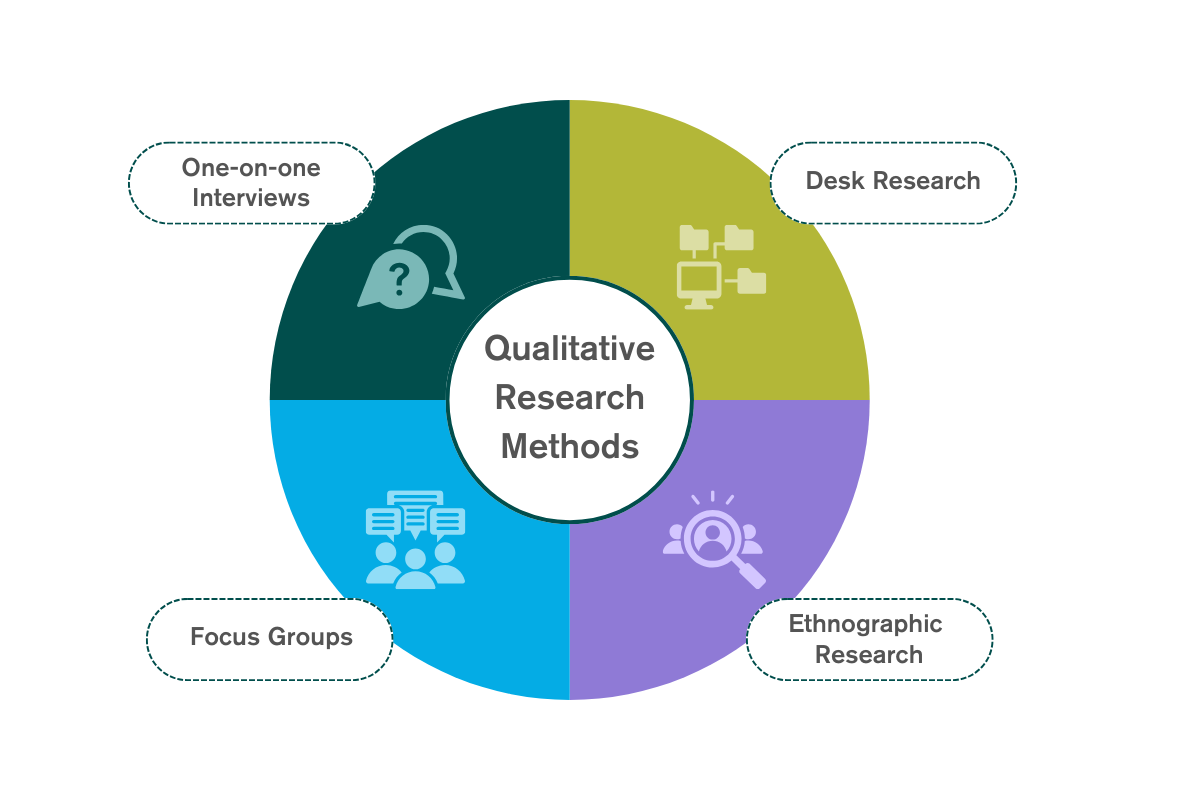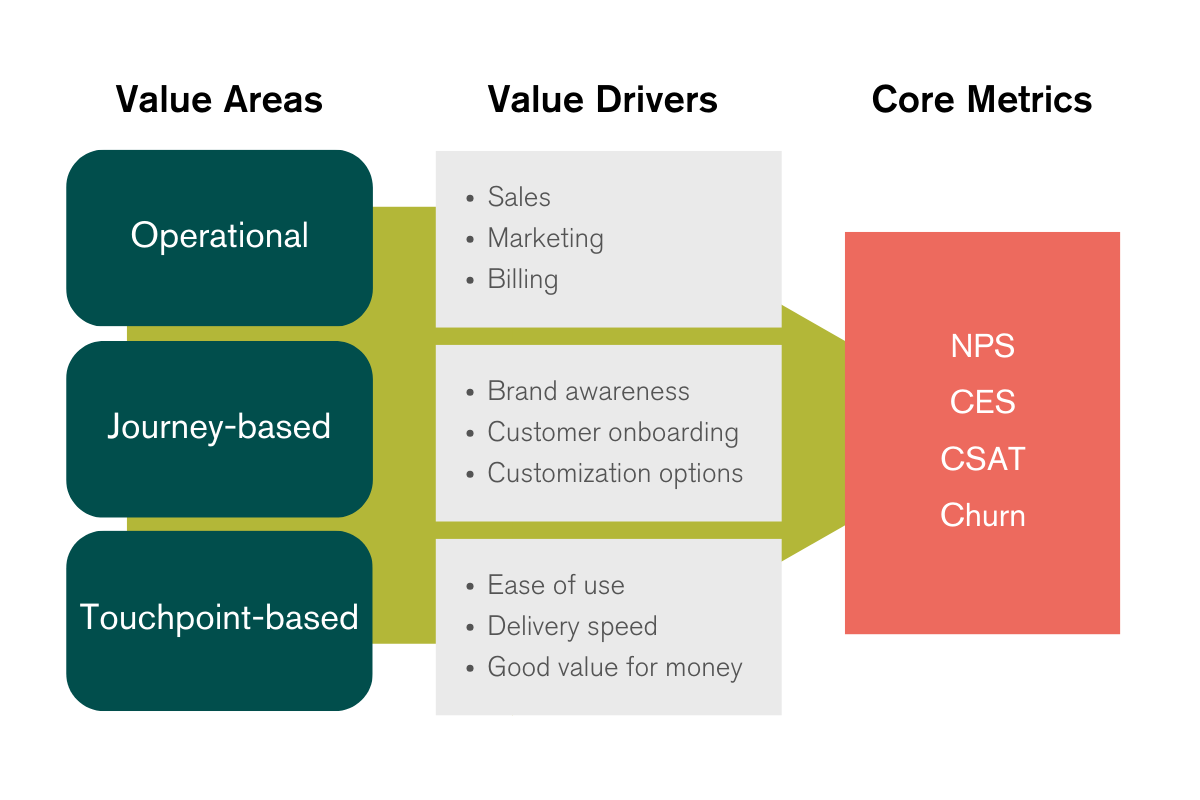
MaxDiff in Market Research: Exploring Its Uses and Benefits
MaxDiff ranks the importance of different attributes to measure customer preference. In this article, we explore how to use MaxDiff in market research to better understand customer decisions.
What is MaxDiff?
Short for Maximum Difference Scaling, MaxDiff analysis is an efficient way to compare large lists of attributes that are important to customers. These attributes could be product features or marketing concepts. Market researchers present potential customers with a list of 3 to 5 attributes and ask them to select the best and worst options. This exercise is repeated multiple times until all the attributes are assessed from the larger list. The data is aggregated to reveal the absolute and relative preference of different attributes.
Also known as the Best-Worst Scaling method, MaxDiff is a statistical trade-off technique that was invented by Professor Jordan Louviere in 1987. At the time, Louviere was a member of faculty at the University of Alberta. He based his idea on the theory of mathematical psychology that respondents will evaluate all the pairing options and choose the pair that reflects the maximum difference in importance. While people are generally good at identifying the best and worst options, their preferences between those extremities are often unclear.

What is the advantage of MaxDiff analysis?
By focusing on extreme ends of the preference scale, MaxDiff offers a more nuanced view of customer priorities. It is particularly advantageous when respondents are asked about numerous attributes or factors in an interview.
When shown a long list of attributes, respondents can struggle to rank their top 5 or indicate their preference on a scale of 1 to 5. This produces biased or inaccurate data. By simplifying the options into the most and least important using MaxDiff, market researchers gather more reliable data about customer preferences in a way that is easy to understand.
MaxDiff vs conjoint
MaxDiff and conjoint analysis are both statistical techniques used in market research to understand customer preference.
The advantages of conjoint analysis
Conjoint analysis uses a more complex survey design than MaxDiff. However, when done correctly, it provides deeper insight into how a wider range of attributes influence customer decisions. This includes different price points or pricing models.
Conjoint analysis asks survey respondents to make choices like a customer. It simulates the trade-off between preferences for different attributes.
As opposed to individual attributes, survey respondents are presented with a holistic product concept. This can be done in one of two ways:
- The first method for conjoint analysis involves asking respondents to rank a hypothetical set of products described by their attributes. For instance, a survey may ask respondents which of 3 tires they prefer. Respondents will be shown the brand, price, tire type (e.g., all-season), and mileage warranty for each tire.
- The second method involves asking respondents a series of questions that trade off different product features. For instance, “do you prefer a tire that costs $80 and has a 65,000-mileage warranty, or a tire that costs $120 and has an 80,000-mileage warranty?”
Simulating real-world scenarios helps respondents to parse out the information and give more accurate responses.

How conjoint compares to MaxDiff
By comparison, MaxDiff asks respondents to consider each attribute individually. In the example above, that would include what is important to them when considering which tire to buy, including brand, price, tire type, and mileage warranty. Each choice set would present a mix of these options, asking respondents to choose the most and least important features. In other words, respondents are indicating preference for specific features, rather than whole product concepts with a price attached.
While MaxDiff is more straightforward and easier for respondents, it does not accommodate different levels of features (e.g., different contract term lengths), or specific price points. By incorporating more detailed pricing information, Conjoint is used to create optimal offers in a research environment to simulate demand and revenue potential.
MaxDiff is best used in earlier stages of strategic decision making. It boils down a longer list of options to a prioritized list of product features and benefits, or concepts that resonate with buyers and are worthy of further exploration.
Meanwhile, conjoint is best used later in the product development process. Fleshed out product and pricing concepts are presented to respondents in a realistic setting to finalize strategic decision making.
How is MaxDiff used in market research?
Maximum Difference Analysis helps businesses to better understand how customers make purchasing decisions. In B2B markets in particular, purchasing decisions are rarely linear; customers will weigh up multiple factors before deciding which product to buy.
Max Diff analysis helps companies to determine what factors are most and least important to their customers. This is used to inform product development, pricing, and marketing and sales strategies.
- Product development research – Product development research uses MaxDiff analysis to determine which product features are more attractive to customers. By asking respondents to identify which product features are most and least important to them, companies can then prioritize features in their product development and marketing strategy. Breaking the data down by market segments helps businesses understand how to best target their product marketing and sales strategy, and even launch new products targeted toward specific market segments.
- Concept testing – Maximum Difference Scaling is useful for testing out different concepts with customers, such as product names or positioning statements. By asking respondents to select the best and worst options, companies can identify which names will resonate most with customers.
- Customer needs assessment – MaxDiff is used in a customer needs assessment to identify what product or service factors that customers prioritize the most and least. This can be broken down by different customer segments, for instance, length of time as a customer, age, spend or geography. This tailors different service models or engagement strategies to different customer segments.
- Pricing research – Pricing research uses MaxDiff to determine which product features or add-on services are preferred. The extent to which customers are willing to pay for these prioritize features or add-on services can then be tested. This determines which product features a customer will pay more for.
- Customer segmentation – MaxDiff is used in customer segmentation studies to determine what is important to different customer segments. The insights help brands to create targeted sales and marketing strategies.
What to consider when designing a survey
When considering MaxDiff design, start with a list of attributes that you believe influence customer decision making. A good place to start is qualitative research, for example, in-depth interviews with salespeople or focus groups with customers.
Ultimately, there may be upwards of 20 attributes that contribute to customers’ decisions. These can be evaluated in their totality through thoughtful survey design, while minimizing bias and maximizing the number of responses.
This is achieved in a number of ways:
- Simplicity – Rather than presenting the full list of attributes, it is broken down into groups of 3 to 5. By limiting the number of options for each question, respondents do not become overwhelmed by choice. This prevents respondent fatigue and ensures greater reliability of the data.
- Repetition – By capturing feedback to several groups of 3 to 5 and repeating options across multiple questions, researchers limit bias in the responses while getting complete feedback. They are also able to gather insights on how customers trade off different attributes against each other.
- Randomization – Randomizing the listed order of the attributes for respondents avoids order bias.
- Clarity – Pretesting the survey with a small sample of respondents can help to iron out potential issues in how attributes are presented. It’s important that attributes and carefully worded and clearly defined.
Analyzing survey data
MaxDiff analysis results in a clear ranking of attributes based on their importance to customers. The simpler process of identifying preference involves looking at the number of times each attribute was ranked as the most and least important, and creating a net performance (i.e., best minus worst scores).
More advanced analysis, including the likes of Hierarchal Bayes Estimation, or Multinomial Logit Models, create individual and population level utility scores. This reflects the relative strength of preference between attributes. These scores can be indexed out of 100 to easily demonstrate preference share, and indicate the strength and direction of customers’ preferences. It enables marketers to prioritize product features or marketing messages.
Using advanced statistical methods, B2B market research companies can uncover deeper insights into different customer segments from the data.
Summary: Benefits of using MaxDiff in market research
MaxDiff surveys provide insights into customer preferences, with a clear ranking on what attributes are most and least important, and relative preference. Compared to more complex statistical methods, such as conjoint analysis, the simplicity of MaxDiff increases respondent engagement and data quality.
To be effective in MaxDiff survey design, it’s important to clearly define the attributes you want to test first through qualitative research. Once you have an idea of all the potential attributes, MaxDiff analysis helps you to narrow down the most and least important. Further analysis will also tell you the strength of these preferences among different customer segments. A B2B market research agency can help you to design and extract insights from a MaxDiff analysis.
The insights gathered from MaxDiff analysis are beneficial for making informed decisions about marketing and sales strategies, particularly for product development, pricing and branding.
Construction Materials Company Drives Growth Through Improved Customer Experience
A construction materials company wanted to drive growth through improving its customer experience among its customer base of industrial manufacturers and installers. The...



